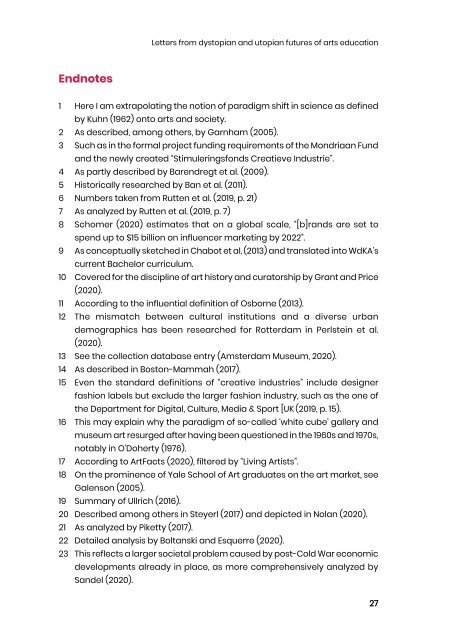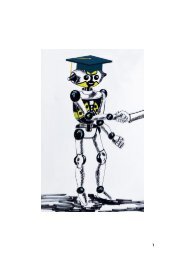17. Letters from dystopian and utopian futures of arts education
You also want an ePaper? Increase the reach of your titles
YUMPU automatically turns print PDFs into web optimized ePapers that Google loves.
<strong>Letters</strong> <strong>from</strong> <strong>dystopian</strong> <strong>and</strong> <strong>utopian</strong> <strong>futures</strong> <strong>of</strong> <strong>arts</strong> <strong>education</strong><br />
Endnotes<br />
1 Here I am extrapolating the notion <strong>of</strong> paradigm shift in science as defined<br />
by Kuhn (1962) onto <strong>arts</strong> <strong>and</strong> society.<br />
2 As described, among others, by Garnham (2005).<br />
3 Such as in the formal project funding requirements <strong>of</strong> the Mondriaan Fund<br />
<strong>and</strong> the newly created “Stimuleringsfonds Creatieve Industrie”.<br />
4 As partly described by Barendregt et al. (2009).<br />
5 Historically researched by Ban et al. (2011).<br />
6 Numbers taken <strong>from</strong> Rutten et al. (2019, p. 21)<br />
7 As analyzed by Rutten et al. (2019, p. 7)<br />
8 Schomer (2020) estimates that on a global scale, “[b]r<strong>and</strong>s are set to<br />
spend up to $15 billion on influencer marketing by 2022”.<br />
9 As conceptually sketched in Chabot et al. (2013) <strong>and</strong> translated into WdKA’s<br />
current Bachelor curriculum.<br />
10 Covered for the discipline <strong>of</strong> art history <strong>and</strong> curatorship by Grant <strong>and</strong> Price<br />
(2020).<br />
11 According to the influential definition <strong>of</strong> Osborne (2013).<br />
12 The mismatch between cultural institutions <strong>and</strong> a diverse urban<br />
demographics has been researched for Rotterdam in Perlstein et al.<br />
(2020).<br />
13 See the collection database entry (Amsterdam Museum, 2020).<br />
14 As described in Boston-Mammah (2017).<br />
15 Even the st<strong>and</strong>ard definitions <strong>of</strong> “creative industries” include designer<br />
fashion labels but exclude the larger fashion industry, such as the one <strong>of</strong><br />
the Department for Digital, Culture, Media & Sport [UK (2019, p. 15).<br />
16 This may explain why the paradigm <strong>of</strong> so-called ‘white cube’ gallery <strong>and</strong><br />
museum art resurged after having been questioned in the 1960s <strong>and</strong> 1970s,<br />
notably in O’Doherty (1976).<br />
17 According to ArtFacts (2020), filtered by “Living Artists”.<br />
18 On the prominence <strong>of</strong> Yale School <strong>of</strong> Art graduates on the art market, see<br />
Galenson (2005).<br />
19 Summary <strong>of</strong> Ullrich (2016).<br />
20 Described among others in Steyerl (2017) <strong>and</strong> depicted in Nolan (2020).<br />
21 As analyzed by Piketty (2017).<br />
22 Detailed analysis by Boltanski <strong>and</strong> Esquerre (2020).<br />
23 This reflects a larger societal problem caused by post-Cold War economic<br />
developments already in place, as more comprehensively analyzed by<br />
S<strong>and</strong>el (2020).<br />
27


















